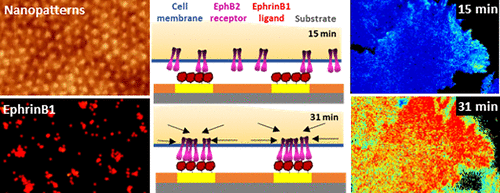Nanopatterns of Surface-Bound EphrinB1 Produce Multivalent Ligand–Receptor Interactions That Tune EphB2 Receptor Clustering
Researchers of NANBIOSIS U7. Nanotechnology Unit, are coauthors of the article “Nanopatterns of Surface-Bound EphrinB1 Produce Multivalent Ligand–Receptor Interactions That Tune EphB2 Receptor Clustering” published by NanoLetters, ACC Publications.
The authors present a nanostructured surface able to produce multivalent interactions between surface-bound ephrinB1 ligands and membrane EphB2 receptors. They have created ephrinB1 nanopatterns of regular size (<30 nm in diameter) by using self-assembled diblock copolymers. Next, they have used a statistically enhanced version of the Number and Brightness technique, which can discriminate—with molecular sensitivity—the oligomeric states of diffusive species to quantitatively track the EphB2 receptor oligomerization process in real time. The results indicate that a stimulation using randomly distributed surface-bound ligands was not sufficient to fully induce receptor aggregation. Conversely, when nanopatterned onto our substrates, the ligands effectively induced a strong receptor oligomerization. This presentation of ligands improved the clustering efficiency of conventional ligand delivery systems, as it required a 9-fold lower ligand surface coverage and included faster receptor clustering kinetics compared to traditional cross-linked ligands.
In conclusion, nanostructured diblock copolymers constitute a novel strategy to induce multivalent ligand–receptor interactions leading to a stronger, faster, and more efficient receptor activation, thus providing a useful strategy to precisely tune and potentiate receptor responses. The efficiency of these materials at inducing cell responses can benefit applications such as the design of new bioactive materials and drug-delivery systems
Article:









